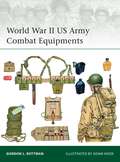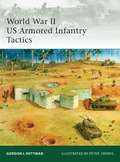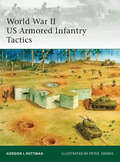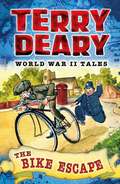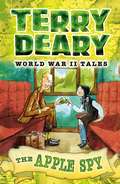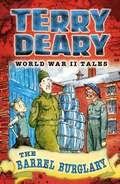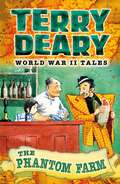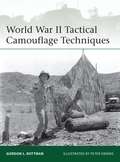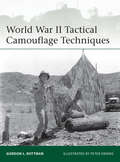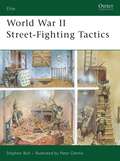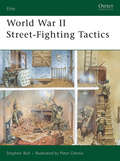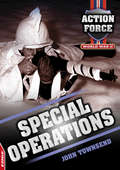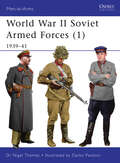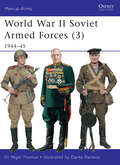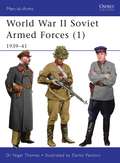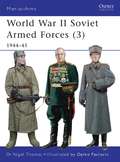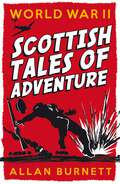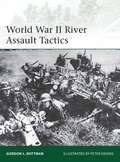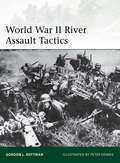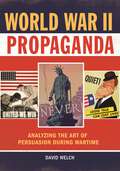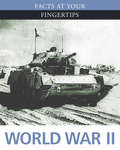- Table View
- List View
World War II US Army Combat Equipments (Elite #210)
by Gordon L. Rottman Mr Adam HookA soldier's "web gear†? is as important to his ability to live and fight on the battlefield as are his clothing and weapons. In World War II the US Army issued equipment items that had originated in 1910, though modified and augmented in the 1920s and 1930s, and again during the war itself as a result of combat experience. This book describes and illustrates the great majority of the personal equipment provided for infantry riflemen, GIs armed with other weapons and their ammunition-bearers, officers, and medics. In addition to the web gear itself it covers canteens, mess kit, and first aid items; weapons-related and other specialist items; the long struggle to produce a practical backpack; bivouac and shelter gear, and the most commonly carried tools. The text also explains the basics of materials, colors, markings, nomenclature, and weights for the guidance of collectors. It is illustrated with wartime photos and color close-ups, and the wide-ranging color plates specially prepared for this book offer more than 130 images.
World War II US Armored Infantry Tactics (Elite #176)
by Peter Dennis Gordon L. RottmanLittle has been published on US armored infantry units and tactics over the years. However, their contribution to the war effort was hugely important. There were a total of 57 armored infantry battalions and two regiments that served throughout the war and in all theaters. Equipped with halftracks, they fought as part of combined arms teams and combat commands alongside tanks, tank destroyers and artillery battalions. Significantly, they were not simply standard infantry battalions provided with halftracks. Their company and platoon organization was very different from the standard infantry unit and these highly mobile, heavily armed battalions fought in an entirely different manner. Using period training manuals and combat reports this book provides an exclusive look at the unique tactics developed by US armored infantry units including movement formations and battle drills.
World War II US Armored Infantry Tactics (Elite #176)
by Gordon L. RottmanLittle has been published on US armored infantry units and tactics over the years. However, their contribution to the war effort was hugely important. There were a total of 57 armored infantry battalions and two regiments that served throughout the war and in all theaters. Equipped with halftracks, they fought as part of combined arms teams and combat commands alongside tanks, tank destroyers and artillery battalions. Significantly, they were not simply standard infantry battalions provided with halftracks. Their company and platoon organization was very different from the standard infantry unit and these highly mobile, heavily armed battalions fought in an entirely different manner. Using period training manuals and combat reports this book provides an exclusive look at the unique tactics developed by US armored infantry units including movement formations and battle drills.
World War II Tales: The Bike Escape (World War II Tales)
by Terry DearyStories of the Second World War on the Home Front from the bestselling Terry Deary, author of the hugely successful Horrible Histories. A young tearaway unwillingly evacuated to the countryside is unjustly accused of theft. He decides to make his way back home, never mind the Blitz - but he'll need to steal a bike to do it...
World War II Tales: The Apple Spy (World War II Tales)
by Terry DearyStories of the Second World War on the Home Front from the bestselling Terry Deary, author of the hugely successful Horrible Histories. In this retelling of an extraordinary true story, a pair of children realise that the odd strangers they see in their tiny Scottish village are German spies. Can the children alert the authorities or will the ruthless spies find them first?
World War II Tales: World War Ii Tales 1 (World War II Tales)
by Terry Deary James De RueStories of the Second World War on the Home Front from the bestselling Terry Deary, author of the hugely successful Horrible Histories. In this retelling of an extraordinary true story, a pair of children realise that the odd strangers they see in their tiny Scottish village are German spies. Can the children alert the authorities or will the ruthless spies find them first?
World War II Tales: World War Ii Tales 2 (World War II Tales)
by Terry Deary James De RueStories of the Second World War on the Home Front from the bestselling Terry Deary, author of the hugely successful Horrible Histories. A young tearaway unwillingly evacuated to the countryside is unjustly accused of theft. He decides to make his way back home, never mind the Blitz - but he'll need to steal a bike to do it...
World War II Tales: World War Ii Tales 3 (World War II Tales)
by Terry Deary James De RueStories of the Second World War on the Home Front from the bestselling Terry Deary, author of the hugely successful Horrible Histories. A story of the old soldiers who made up the Home Guard, and the young people who helped them. The Home Guard of a small town need supplies but the local factory owner won't help. So they decide to use unconventional methods...
World War II Tales: World War Ii Tales 4 (World War II Tales)
by Terry Deary James De RueStories of the Second World War on the Home Front from the bestselling Terry Deary, author of the hugely successful Horrible Histories. With food scarce and rationing taking hold, plenty of people turned to the black market to get more than their share. In this tale, a girl finds herself mixed up in a spiv's illegal dealings - and what is the secret of the haunted farm?
World War II Tactical Camouflage Techniques (Elite)
by Peter Dennis Gordon L. RottmanThis book explains and illustrates the actual materials and techniques adopted (both successfully and unsuccessfully) by tactical units – i.e. the concealment of personnel, weapons, equipment, field positions, and movement by infantry riflemen and weapons crews, artillerymen, and vehicle crews. It covers all areas and seasons in the European and Mediterranean theaters of operations, for the US, British, German, and Soviet armies. It includes camouflage of the person, personal equipment, and weapons; natural materials and "expedient†? techniques; issued camouflage materials such as nets, ponchos, etc; the principles of camouflaging equipment and vehicles, of positioning and terrain integration, the effects of light and shadow, and the use of decoy and dummy positions. Featuring meticulous full-color artwork and specially selected period photographs, this absorbing study casts new light on the camouflaging techniques developed by the major armies of World War II on a host of European battlefields.
World War II Tactical Camouflage Techniques (Elite)
by Peter Dennis Gordon L. RottmanThis book explains and illustrates the actual materials and techniques adopted (both successfully and unsuccessfully) by tactical units – i.e. the concealment of personnel, weapons, equipment, field positions, and movement by infantry riflemen and weapons crews, artillerymen, and vehicle crews. It covers all areas and seasons in the European and Mediterranean theaters of operations, for the US, British, German, and Soviet armies. It includes camouflage of the person, personal equipment, and weapons; natural materials and "expedient†? techniques; issued camouflage materials such as nets, ponchos, etc; the principles of camouflaging equipment and vehicles, of positioning and terrain integration, the effects of light and shadow, and the use of decoy and dummy positions. Featuring meticulous full-color artwork and specially selected period photographs, this absorbing study casts new light on the camouflaging techniques developed by the major armies of World War II on a host of European battlefields.
World War II Street-Fighting Tactics (Elite)
by Peter Dennis Stephen BullIn a continuation of the tactics mini-series, this book analyzes the physical tactics of the close-quarter fighting that took place in ruined cities during World War II. Street-to-street fighting in cities was not a new development, but the bombed-out shells of cities and advances in weaponry meant that World War II took such strategies to a new level of savagery and violence. Packed with eye-witness accounts, tutorials from original training manuals, maps, and full-colour artwork, this is an eye-opening insight into the tactics and experiences of infantry fighting their way through ruined cities in the face of heavy casualty rates and vicious resistance.
World War II Street-Fighting Tactics (Elite #168)
by Peter Dennis Stephen BullIn a continuation of the tactics mini-series, this book analyzes the physical tactics of the close-quarter fighting that took place in ruined cities during World War II. Street-to-street fighting in cities was not a new development, but the bombed-out shells of cities and advances in weaponry meant that World War II took such strategies to a new level of savagery and violence. Packed with eye-witness accounts, tutorials from original training manuals, maps, and full-colour artwork, this is an eye-opening insight into the tactics and experiences of infantry fighting their way through ruined cities in the face of heavy casualty rates and vicious resistance.
The World War II Story (Story Ser.)
by Chris McNabIn September 1939, Hitler’s Nazi Germany invaded Poland. Thus began the greatest armed struggle in history. Within days of the invasion, Germany was at war with France, Great Britain and much of the Commonwealth, but by the end of 1941 – by which time Japan and the United States had been plunged into war – the conflict had engulfed virtually the entire planet. World War II witnessed the mobilisation of more than 100 million military personnel. Here was ‘total war’ on a scale never previously experienced by any of the countries involved. The conflict eclipsed everything: industry, technology, the economy and home life. It transformed the lives of an entire generation of men and women, who grew up under the shadow of violence, separation and loss. It was also fought in every conceivable terrain and theatre, from the arctic conditions of the Soviet winter to the tropical landscape of the Pacific islands, with the battle for seas and skies being equally brutal. By the time it ended in September 1945, World War II had claimed the lives of more than 50 million people, and it witnessed the only use of nuclear weapons in warfare to this day. The World War II Story charts the dramatic narrative of the conflict from its first shots to its final apocalyptic end.
World War II: Special Operations (EDGE: Action Force #6)
by John TownsendInside SPECIAL OPERATIONS: Secret missions- US Rangers - S.O.E. - Special Air Service (SAS) - Devil's Brigade - Case studies - US Marine Raiders - Spies, plus much more!Get tough with some of World War II's fighting men and units. From battlefield frontlines to Naval convoys, from secret missions to aerial dogfights, Action Force brings together the people, weapons, vehicles, the stats and the facts in one all-action World War II series. You want action packed? Read Action Force!
World War II Soviet Armed Forces: 1939–41 (Men-at-Arms #464)
by Nigel ThomasThis book is a detailed analysis of the Soviet Army at the outbreak of World War II, including the Red Army's campaigns against Japan on the Manchurian plains as well as in Finland. It covers the Red Army's first operations during Operation Barbarossa when the Red Army was forced to defend Mother Russia against the German onslaught. It offers a breakdown of all the armed forces including the army, air force, paratroopers, navy and NKVD troops. In particular it covers the evolution of uniforms, equipment and insignia with the introduction of new regulations in 1935 and 1940.
World War II Soviet Armed Forces: 1944–45 (Men-at-Arms #469)
by Nigel ThomasThis book presents a detailed analysis of the Soviet armed forces during the final days of the war, covering the soldiers that successfully turned the tide against the Nazi onslaught and pushed it back into Germany itself. This final part of the series documents the Red Army's push through Germany to Berlin, which eventually culminated in the surrender of the German forces to the Allies in 1945. It also offers a detailed breakdown of all the armed forces that conducted the offensive campaigns on the Eastern Front, including the army, air force, paratroopers, navy and NKVD troops. Its colourful illustrations also include the uniforms and organizations of the Russian forces serving against Japan until the eventual surrender of all Japanese Imperial forces in August 1945.
World War II Soviet Armed Forces: 1939–41 (Men-at-Arms)
by Nigel Thomas Darko PavlovicThis book is a detailed analysis of the Soviet Army at the outbreak of World War II, including the Red Army's campaigns against Japan on the Manchurian plains as well as in Finland. It covers the Red Army's first operations during Operation Barbarossa when the Red Army was forced to defend Mother Russia against the German onslaught. It offers a breakdown of all the armed forces including the army, air force, paratroopers, navy and NKVD troops. In particular it covers the evolution of uniforms, equipment and insignia with the introduction of new regulations in 1935 and 1940.
World War II Soviet Armed Forces: 1944–45 (Men-at-Arms)
by Nigel Thomas Darko PavlovicThis book presents a detailed analysis of the Soviet armed forces during the final days of the war, covering the soldiers that successfully turned the tide against the Nazi onslaught and pushed it back into Germany itself. This final part of the series documents the Red Army's push through Germany to Berlin, which eventually culminated in the surrender of the German forces to the Allies in 1945. It also offers a detailed breakdown of all the armed forces that conducted the offensive campaigns on the Eastern Front, including the army, air force, paratroopers, navy and NKVD troops. Its colourful illustrations also include the uniforms and organizations of the Russian forces serving against Japan until the eventual surrender of all Japanese Imperial forces in August 1945.
World War II: Scottish Tales of Adventure
by Allan BurnettAcclaimed children's author Allan Burnett turns his attention to the Second World War in a book of explosively exciting and emotionally charged tales of bravery and adventure. Featuring the true exploits of soldiers, spies, pilots, sailors and many others, these stories, all based on interviews with these heroes themselves or their descendants, offer a unique, personal insight into the Second World War that no conventional history book can ever hope to match.
World War II River Assault Tactics (Elite #195)
by Peter Dennis Gordon L. RottmanOn the major European and Russian fronts throughout World War II, the challenge of crossing rivers under fire was absolutely central to any advance. The Panzers that crossed the Meuse at Sedan in May 1940 cut the French Army in two. The Wehrmacht's ability to cross the great rivers of the western USSR was vital to the lightning advances of Operation Barbarossa in 1941, and in 1943–45 the Red Army had to drive the Germans back from a succession of river lines during their advance to the Reich, culminating in the Vistula and Oder lines. With World War II armies dependent on heavy mechanized equipment, the function which rivers played became essential for soldiers in all sides of the war. World War II River Assault Tactics details the methods, means and analysis of specific successes and failures. Featuring a wealth of wartime photos, particularly from German sources, and full-colour plates illustrating tactical scenarios, the subject is brought to life.
World War II River Assault Tactics (Elite #195)
by Peter Dennis Gordon L. RottmanOn the major European and Russian fronts throughout World War II, the challenge of crossing rivers under fire was absolutely central to any advance. The Panzers that crossed the Meuse at Sedan in May 1940 cut the French Army in two. The Wehrmacht's ability to cross the great rivers of the western USSR was vital to the lightning advances of Operation Barbarossa in 1941, and in 1943–45 the Red Army had to drive the Germans back from a succession of river lines during their advance to the Reich, culminating in the Vistula and Oder lines. With World War II armies dependent on heavy mechanized equipment, the function which rivers played became essential for soldiers in all sides of the war. World War II River Assault Tactics details the methods, means and analysis of specific successes and failures. Featuring a wealth of wartime photos, particularly from German sources, and full-colour plates illustrating tactical scenarios, the subject is brought to life.
World War II Propaganda: Analyzing the Art of Persuasion during Wartime
by David WelchShows in illuminating detail how the Allied and Axis forces used visual images and other propaganda material to sway public opinion during World War II.Author David Welch provides a neatly organized primary resource that focuses on key themes associated with World War II propaganda. Readers will not only be engrossed with a wide range of propaganda artifacts, they will also receive a better and more nuanced understanding of the nature of this propaganda and how it was disseminated in different cultural and political contexts. This book reveals how leaders and spin doctors operating at behest of the state sought to shape popular attitudes both at home and overseas. A comprehensive introductory essay sets out the principles of propaganda theory in World War II, while the subsequent material provides examples of Allied- and Axis-generated propaganda and presents them in a readily accessible way that will help readers understand the context.
World War II Propaganda: Analyzing the Art of Persuasion during Wartime
by David WelchShows in illuminating detail how the Allied and Axis forces used visual images and other propaganda material to sway public opinion during World War II.Author David Welch provides a neatly organized primary resource that focuses on key themes associated with World War II propaganda. Readers will not only be engrossed with a wide range of propaganda artifacts, they will also receive a better and more nuanced understanding of the nature of this propaganda and how it was disseminated in different cultural and political contexts. This book reveals how leaders and spin doctors operating at behest of the state sought to shape popular attitudes both at home and overseas. A comprehensive introductory essay sets out the principles of propaganda theory in World War II, while the subsequent material provides examples of Allied- and Axis-generated propaganda and presents them in a readily accessible way that will help readers understand the context.
World War II: Day By Day (Facts at Your Fingertips: Military History #2)
by Antony ShawThis book on World War II examines in detail the conflict that was fought across the globe between 1939 and 1945. For each battle featured, such as Kursk, Stalingrad and Midway, there is a description of the events, casualty figures and key actions, with maps throughout. This book presents all the facts of a war that remains within living memory.
